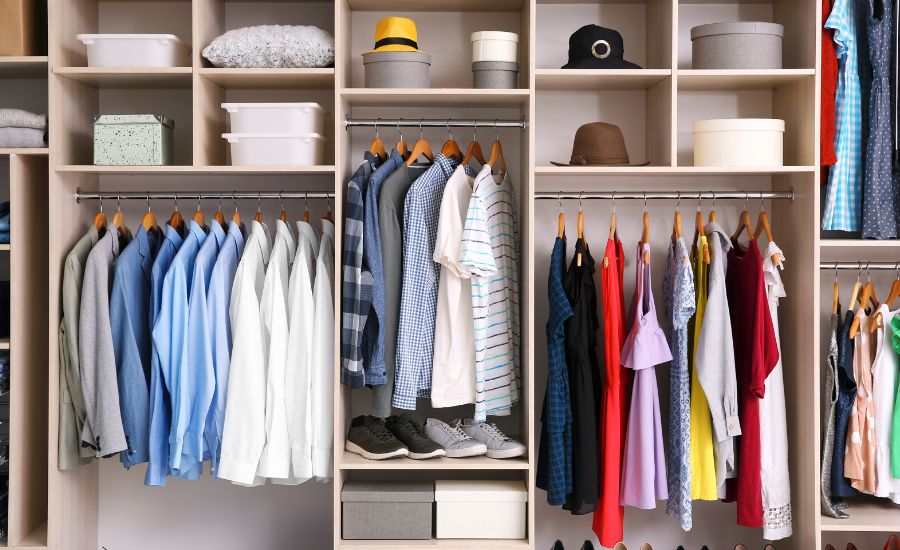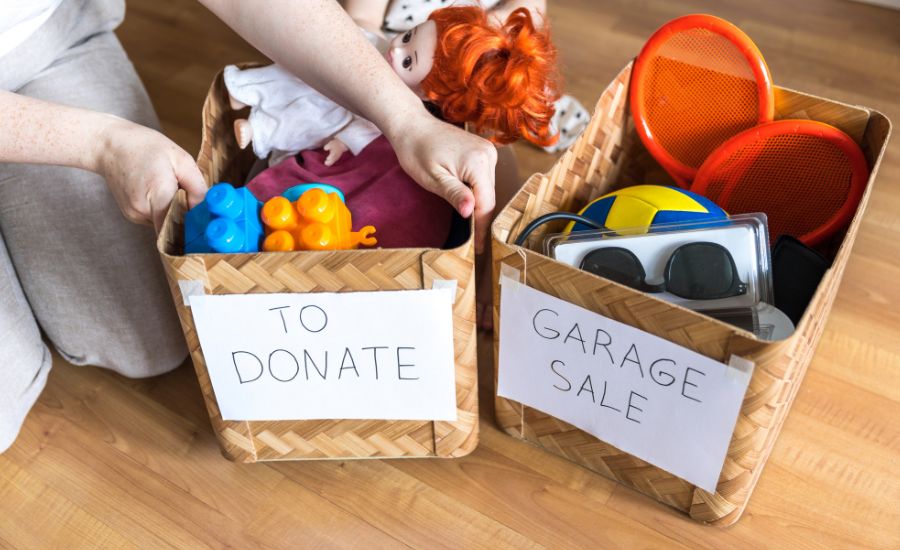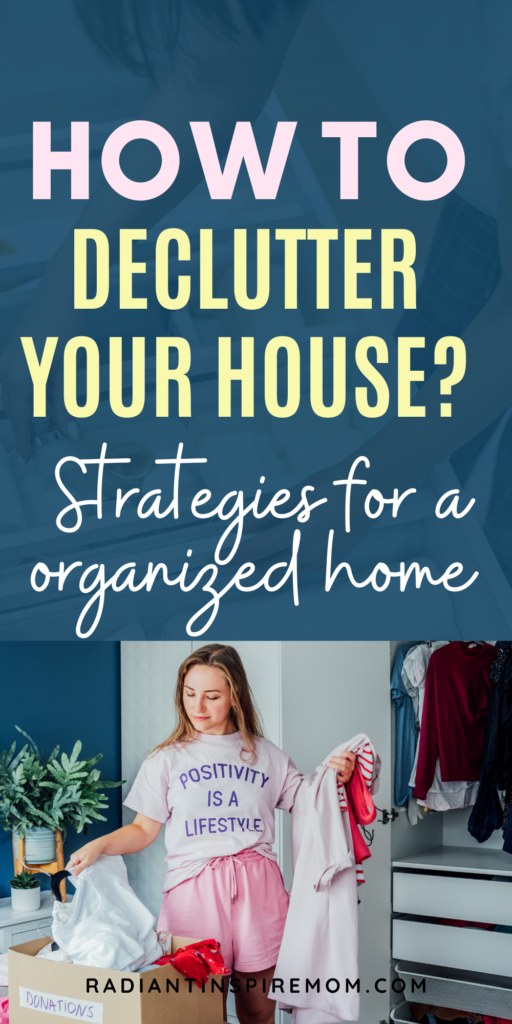Decluttering your house can feel like a monumental task, but it doesn’t have to be overwhelming. Start by tackling one room at a time and focus on what you truly need and use. This approach helps make the process more manageable less stressful, and helpful to declutter your house.
You might find it helpful to set clear goals for each space. Decide what you want to keep, donate, or throw away. This will guide your efforts and keep you on track as you sort through your items.
Remember that decluttering isn’t just about getting rid of things; it’s about creating a more organized and enjoyable living space. As you clear out what you no longer need, you’ll likely feel a sense of relief and freedom.

Benefits of Decluttering
Decluttering your home offers many advantages. Here are some key benefits you might notice:
1. Reduced Stress
A clean and organized space can help lower stress levels. When your environment is tidy, it’s easier to focus and relax.
Living in a cluttered space often causes mental overwhelm and stress. When your home is free of unnecessary items, it promotes a sense of calm and order.
Decluttering removes visual distractions, making it easier to focus on daily tasks. The act itself can be therapeutic, giving you a sense of accomplishment. A clean environment can improve mental health by creating a more peaceful atmosphere.
2. Increased Space
Removing items you no longer need frees up space. This extra room can make your home feel more open and inviting.
You’ll notice more open space in your home when you remove items you no longer use.
The extra room makes your home feel more extensive and more comfortable. This newfound space can be repurposed for activities like yoga, reading, or spending quality time with family.
Moving around and enjoying your living areas is more accessible without unnecessary obstacles. This benefit also extends to storage, as organized closets and drawers provide a more functional room.
3. Set a Positive Example
When you declutter, it inspires those around you to do the same. A tidy home can motivate family members to adopt better organizational habits. Teaching children about decluttering instills lifelong skills of responsibility and mindfulness.
Your efforts may even inspire friends or neighbors to simplify their own spaces.
Decluttering sets the stage for a more positive and intentional way of living, influencing others to follow suit.
Decluttering can prevent accidents. Clearing pathways reduces the risk of tripping and makes moving around easier.

4. Easier Cleaning
With fewer items in your home, cleaning becomes quicker and simpler. A decluttered home is significantly more straightforward to clean and maintain. Without piles of unnecessary items, surfaces are more accessible for dusting, vacuuming, and wiping.
Regular cleaning becomes faster and less overwhelming when every item has its designated place.
Simplifying your space reduces cleaning stress, allowing you to enjoy a consistently tidy and inviting home.
5. Better Productivity
An organized space can boost productivity. It is easier to concentrate when your surroundings are neat.
Clutter can make it challenging to find what you need, leading to wasted time. A tidy home allows for better organization, so you can quickly locate items.
When your surroundings are in order, your mind feels clearer, helping you focus better on work or personal projects.
Decluttering can also motivate you to maintain other organized habits. Overall, it sets a productive tone for your daily routine.
6. Enhanced Creativity
A clutter-free environment can spark creativity. With fewer distractions, your mind can explore new ideas more freely.
A clean and organized space allows your mind to think freely without distractions. Creative activities like writing, painting, or crafting thrive in a decluttered environment.
With less chaos, you can concentrate better on your hobbies and passions.
Rearranging your space after decluttering can also inspire new ideas for home decor. Your home becomes a canvas for self-expression rather than a source of frustration.
7. Sense of Accomplishment
Completing a decluttering project gives you a sense of achievement. It can motivate you to tackle other tasks in your life.
These benefits show how decluttering refreshes your home and improves your daily life.
8. Improves Physical Health
Clutter collects dust, allergens, and dirt, which can affect your health. A decluttered home is easier to clean and reduces allergens that can trigger respiratory issues.
The physical act of decluttering is also a form of light exercise, keeping you active.
With a clean space, you’re more likely to cook at home, fostering healthier eating habits. A clutter-free home can promote better sleep by creating a calming bedroom environment.
9. Saves Money
When your belongings are well-organized, you avoid buying duplicates of items you forgot you had. Decluttering can also reveal unused items you can sell or donate, potentially earning you extra cash.
Maintaining an organized home makes you less tempted to make impulse purchases.
Fewer possessions mean reduced costs for storage solutions or moving. In the long term, it helps you focus on quality over quantity when shopping.
10. Strengthens Decision-Making Skills
Decluttering requires choosing what to keep and what to let go of. This practice enhances your ability to evaluate and prioritize, which can be applied to other areas of life.
As you gain confidence in these decisions, you become better at setting boundaries and saying no to unnecessary commitments.
Decluttering also helps you identify what truly adds value to your life. Over time, these skills contribute to a more intentional and mindful lifestyle.
11. Increases Energy Levels
Clutter can feel like a weight on your shoulders, draining your energy. A clean, organized home feels lighter, lifting your mood and boosting energy levels.
You’ll feel more motivated to tackle other tasks when your surroundings are in order.
With less to clean or manage, you can redirect your energy toward hobbies or personal growth. Decluttering can also lead to a more active lifestyle as you reclaim physical space for movement.
12. Promotes a Sense of Gratitude
Decluttering allows you to rediscover and appreciate the items that truly matter to you. By letting go of what you don’t need, you can focus on the possessions that bring joy or serve a purpose.
This practice fosters gratitude for the things you already have rather than focusing on what you lack. It also encourages a more minimalist mindset, helping you prioritize quality over quantity.
Gratitude cultivated through decluttering can enhance overall happiness.

Preparation for Decluttering
Getting ready to declutter your home is essential for a more organized space. Think about what you want to achieve, how you will get there, and what tools you will need. This process will help you stay focused and motivated.
Setting Decluttering Goals
Start by defining clear goals for your decluttering project. Ask yourself what specific areas you want to tackle. For example:
- Living Room: Reduce items to create a more inviting space.
- Bedroom: Make room for relaxation by getting rid of clothes and clutter.
- Kitchen: Clear counters and simplify your cooking space.
Having specific goals helps you stay on track and makes it easier to measure your progress. Take time to write down these goals. Keep them visible as you work to remind yourself of what you are trying to achieve.

Creating a Decluttering Plan
Next, create a step-by-step plan for your decluttering process. Start by deciding when you will begin. Set aside dedicated time for each area. You can do one room daily or tackle smaller sections like closets or drawers.
Outline your approach:
- Start Small: Begin with a single drawer or shelf.
- One Area at a Time: Focus on one room or section before moving to the next.
- Daily Goals: Set small, achievable targets like removing ten daily items.
Having a clear plan helps you avoid feeling overwhelmed. Stick to your schedule to see steady progress as you declutter.
Gathering Supplies
Gather all the supplies you will need before you start. This includes boxes, bags, and labels to help sort items effectively. Make sure to have these handy:
- Trash Bags: For items that are broken or no longer needed.
- Donation Boxes: For items in good condition that you no longer want.
- Label Maker: Helps keep everything organized and easy to find.
Having these supplies ready ensures you can focus on the task. You will spend less time looking for materials and more time decluttering your home.

Executing the Decluttering Process
To declutter effectively, you need to sort your items, apply systematic methods, and make sound decisions about what to keep. This approach will help you create a more organized and peaceful living space.
Sorting Your Items
Start by gathering all similar items in one place. For instance, collect clothes, books, or kitchen tools. This will give you a clear view of what you own.
Next, categorize these items into three groups: Keep, Donate, and Discard. The “Keep” pile is for items you use regularly or that hold significant value. The “Donate” pile includes things in good condition that you no longer need. The “Discard” pile is for broken or unusable items.
Go through each category thoughtfully. Ask yourself questions like: Do I use this often? Does it bring me joy? This process allows you to see everything at once and makes decision-making easier.

Systematic Decluttering Methods
Choosing a method can streamline your work. One popular way is the Four-Box Method.
Label four boxes as Keep, Donate, Trash, and Storage. As you go through each item, could you place it in one of the boxes? This method helps keep your choices organized.
Another option is the One-In-One-Out Rule. For every new item you bring into your home, remove one item. This helps maintain the balance and prevents future clutter.
You could also tackle one room at a time or set a daily timer for 15-30 minutes. These techniques make decluttering less overwhelming and encourage consistent progress.
Decision-Making Tips
Making decisions can be challenging. To make it easier, consider a few helpful tips. First, ask yourself if you’ve used the item in the past year. If not, it may be time to let it go.
Second, keep only items that serve a purpose or have emotional value. Avoid keeping items out of guilt or obligation.
Third, try the 30-Day Rule. If you consider purchasing something, wait 30 days. If you still want it after that time, then buy it. This helps you focus on what you genuinely need and reduce impulse buying.
Organizing Post-Declutter
After decluttering, the next step is to organize your items effectively. This ensures that your home remains tidy and functional. Proper organization can help you find things easily and keep surfaces clear.
Storage Solutions
Choosing the proper storage solutions is crucial. Start by assessing what items you have left. Use boxes, baskets, or bins to group similar items. Labeling these containers makes it easier to find what you need without searching.
Consider vertical storage options like shelves. This can free up floor space. Floating shelves and bookcases can hold books, plants, or decorative items.
For smaller spaces, think about multi-functional furniture. Ottomans with storage or coffee tables with drawers can provide extra places to stash things. Also, utilize the space under the bed with bins or drawers to keep items out of sight.

Maintaining a Clutter-Free Space
Once you have organized your home, maintaining that order is essential. Set aside a few minutes daily to put things back in their designated spots. Developing a habit of tidying up prevents future clutter.
Create a simple routine. For example, at the end of the day, put away any out-of-place items. Use the “one in, one out” rule: For every new item you bring in, consider donating or discarding one.
Regular check-ins are also helpful. Schedule a monthly review of your spaces to ensure everything is in order. Maintaining a tidy home is easier when you regularly assess your organization system.
Responsible Disposal
Managing unwanted items is essential for a clean home and a sustainable environment. You have options for responsibly disposing of your belongings. Here are effective ways to deal with items you no longer need.
Selling Unwanted Items
Selling items can be an intelligent choice. Start by collecting things you no longer use or need. Consider using online platforms like eBay, Facebook Marketplace, or Craigslist. Local garage sales are another excellent option.
Clean and photograph your items well. Provide clear descriptions to attract buyers. Price items fairly; research similar listings to see what they sell for.
Arrange safe payment methods. Always meet buyers in public places or use secure shipping options. This approach helps you declutter while earning some extra cash.

Donating to Charity
Donating items can help others and reduce waste. Choose a charity that aligns with your values. Popular options include Goodwill, Salvation Army, or local shelters.
Before donating, check their rules on accepted items. Clothing, household goods, and toys are often welcome. Ensure items are clean and in good condition.
Get a receipt for your donation if you want a tax deduction. This way, you can support charities while also clearing out your home, and your unwanted items can benefit someone else in need.
Recycling and Upcycling
Recycling is another responsible option for unwanted items. Check your local recycling guidelines for specific rules. Common recyclable items include paper, plastic, glass, and electronics.
For things that can’t be recycled, consider upcycling. Upcycling means transforming items into something new and useful. For example, you can turn old jars into storage containers.
Look for creative ideas online for inspiration. Upcycling can be fun and helps reduce landfill waste. Both recycling and upcycling are great choices for responsible disposal.
Tips for Living with Less
Living with less can create a more peaceful and organized space. You can enjoy simplicity in your home by adopting mindful habits and a few practical rules.
Mindful Shopping Habits
Before buying something new, ask yourself if you truly need it. Make a list of what you need to avoid impulse purchases. Stick to this list while shopping to help resist unnecessary items.
When you do shop, consider quality over quantity. Investing in well-made items often means they will last longer, reducing future clutter. Be aware of sales promotions that can tempt you into buying things you don’t need.
Taking time to think before shopping will help you maintain a clutter-free home and ensure that what you own has real value.
The One In, One Out Rule
The One In, One Out Rule is straightforward: remove one item for every new item you bring into your home. This can help keep your space from getting cluttered.
Start by applying this rule in one area, like your closet. When you buy a new shirt, donate or sell an old one. This keeps your belongings manageable and encourages you to be selective about new purchases.
This practice helps you stay mindful of what you own and can lead to a more minimalist lifestyle.
Regular Decluttering Schedules
Set a regular schedule for decluttering your home. Choose a day each month or every season to go through your belongings. This can prevent clutter from building up.
During your scheduled decluttering, focus on specific areas, like drawers or cabinets. Decide which items to keep, donate, or throw away. Remember to be honest with yourself about what you indeed use and need.
Regular decluttering keeps your home tidy and allows you to enjoy the space you create without excess.
What are some practical decluttering tips for individuals who hoard?
Start small. Choose one area to work in, like a drawer or a room corner. Focusing on a small space makes it less overwhelming.
Set clear goals. Decide what you want to achieve with your decluttering. For example, you might aim to clear a specific space or get rid of a certain number of items each week.
Use the “four-box method.” Label four boxes as keep, donate, trash, and unsure. This helps you sort items quickly and decide what to do with them.
Create a timeline. Make a schedule for when to declutter. Set aside time each day or week to work on this task. Stick to your schedule to build momentum.
Ask for help. You don’t have to do this alone. Involve a friend or family member who can support you through the process. They can offer a fresh perspective.
Consider emotional attachments. Consider why you keep certain items. It might be time to let them go if they don’t serve a purpose. Reflect on what truly matters to you.
Reward yourself. Once you complete a decluttering task, treat yourself. This could be a small snack, a break to watch your favorite show or anything that feels like a reward.
Remember, progress takes time. Celebrate small victories and keep moving forward, even if it feels slow.
What are the best strategies for decluttering a home quickly?
Decluttering can feel overwhelming. Here are some effective strategies to help you get it done fast.
1. Start Small
Choose one area to tackle first. This could be a single drawer or a small room. Completing a small task builds momentum.
2. Use the Four-Box Method
Get four boxes and label them:
- Keep
- Donate
- Trash
- Relocate
As you review your items, place each in the appropriate box.
3. Set a Timer
Give yourself a time limit. For example, work for 20 or 30 minutes. This helps you focus and work quickly.
4. Implement the One-Year Rule
If you haven’t used something in the last year, consider removing it. This rule helps you decide what to keep.
5. Limit Replacements
When you bring in something new, let go of something old. This keeps clutter from building back up.
6. Take Breaks
Short breaks can help you recharge. After a focused decluttering session, step back for a few minutes to clear your mind.
7. Get Help
Ask a friend or family member to help. They can provide support and new perspectives.

Frequently Asked Questions
Decluttering can raise many questions. Here are some common concerns and helpful strategies for a smoother process.
What is a simple checklist to follow for decluttering a home?
- Start small: Pick one area, like a drawer or shelf.
- Sort items: Create three piles: keep, donate, and trash.
- Evaluate each item: Ask yourself if you use it or love it.
- Organize what’s left: Find a designated space for each item.
- Maintain: Set a schedule to revisit and declutter regularly.
How can you declutter your house while still wanting to keep most items?
Focus on keeping items that truly matter to you. Start by limiting the space for your belongings, like using one box for keepsakes. If something doesn’t fit, consider if it’s worth keeping. Also, take photos of items you want to remember but don’t need to stay physically.
Could you explain the 12-12-12 challenge in decluttering?
The 12-12-12 challenge is a fun way to declutter. You find 12 items to toss, 12 to donate, and 12 to return to their proper place. This method encourages you to think more about your belongings and makes the process less overwhelming. It’s a simple way to see quick results and stay motivated.
23 small apartment living room ideas for maximum space
16 Fall and Halloween Bedroom Decor Ideas